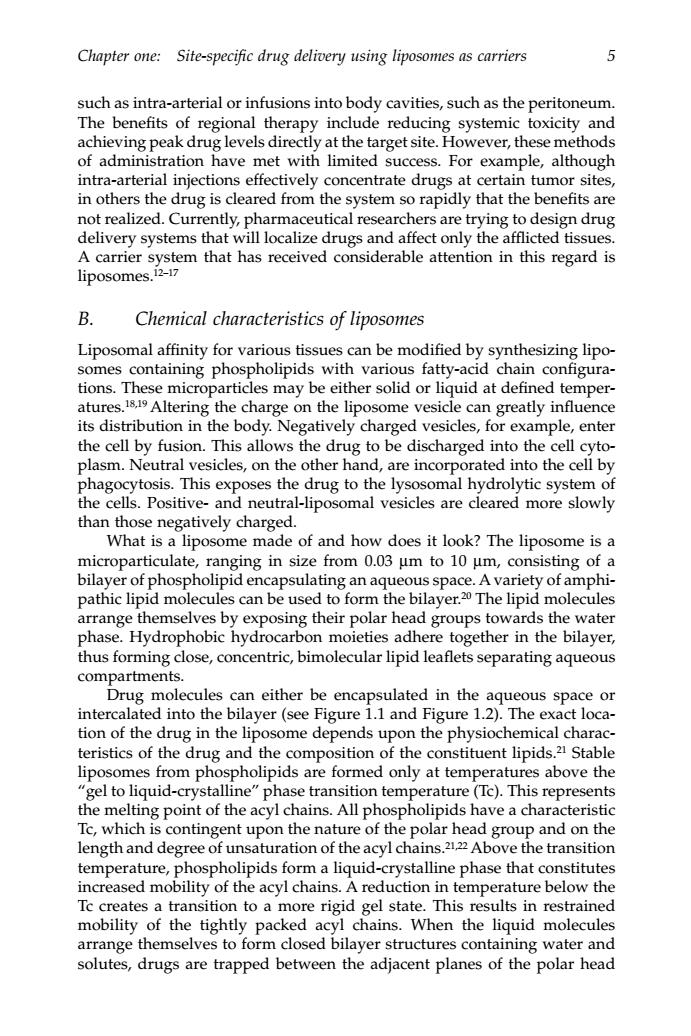正在加载图片...

Chapter one:Site-specific drug delivery using liposomes as carriers such as intra-arterial or infusions into body cavities,such as the peritoneum The benefits of regional therapy include reducing systemi toxicity and achieving peak drug levels directly at the target site.However,these methods of administration have met with limited success.For example,although intra-arterial injections effectively concentrate drugs at certain tumor sites in others the drug is cleared from the system so rapidly that the benefits are not realized.Currently delivery systems cdrugs and affect only the afflicted tissues. ers ar trying to design drug A carrier system that has received considerable attention in this regard is liposomes. B. Chemical characteristics of liposomes Liposomal affinity for various tissues can be modified by synthesizing lipo ontaining phe holipids with varic id con figura tions.Th fatty cropartic les may be either solid or liquid at defined temper atures. ltering the charge on the liposome vesicle can greatlyn its distribution in the body.Negatively charged vesicles,for example,enter the cell by fusion.This allows the drug to be discharged into the cell cyto- plasm.Neutral vesicles,on the other hand,are incorporated into the cell by phago 。Thi exp drolytic syst Positive neutral-liposomal vesi more slowly than those negatively charged What is a liposome made of and how does it look?The liposome is a microparticulate,ranging in size from 0.03 um to 10 um,consisting of a bilayer of phospholipid e ous space.A variety of amphi- pathi encapsulating an aqu ic lip s can be us sed to fo bilayer.The e lipi the wate phase.Hydrophobic hydrocarbon moieties adhere together in the bilaver thus forming close,concentric,bimolecular lipid leaflets separating aqueous compartments. Drug 1.2).The of the uin heposome depends upon the physichemcalch teristics of the drug and the composition of the constituent lipids.21 Stable liposomes from phospholipids are formed only at temperatures above the gel to liquid-crystalline"phase transition temp erature (Tc).This represents the meltin g point of the acyl chains.All phospholipids have a characteristic contingent upon th i group and on the length and degree of unsaturation of the acyl chains.2 temperature,phospholipids form a liquid-crystalline phase that constitutes increased mobility of the acyl chains.A reduction in temperature below the Tc creates a transition to a more rigid gel state.This results in restrained mobility of the tightly packed ac I chains.When the liquid molecules rrange themselves to form closed bilayer structure f and solutes,drugs are trapped between the adjacent planes of the polar headChapter one: Site-specific drug delivery using liposomes as carriers 5 such as intra-arterial or infusions into body cavities, such as the peritoneum. The benefits of regional therapy include reducing systemic toxicity and achieving peak drug levels directly at the target site. However, these methods of administration have met with limited success. For example, although intra-arterial injections effectively concentrate drugs at certain tumor sites, in others the drug is cleared from the system so rapidly that the benefits are not realized. Currently, pharmaceutical researchers are trying to design drug delivery systems that will localize drugs and affect only the afflicted tissues. A carrier system that has received considerable attention in this regard is liposomes.12–17 B. Chemical characteristics of liposomes Liposomal affinity for various tissues can be modified by synthesizing liposomes containing phospholipids with various fatty-acid chain configurations. These microparticles may be either solid or liquid at defined temperatures.18,19 Altering the charge on the liposome vesicle can greatly influence its distribution in the body. Negatively charged vesicles, for example, enter the cell by fusion. This allows the drug to be discharged into the cell cytoplasm. Neutral vesicles, on the other hand, are incorporated into the cell by phagocytosis. This exposes the drug to the lysosomal hydrolytic system of the cells. Positive- and neutral-liposomal vesicles are cleared more slowly than those negatively charged. What is a liposome made of and how does it look? The liposome is a microparticulate, ranging in size from 0.03 mm to 10 mm, consisting of a bilayer of phospholipid encapsulating an aqueous space. A variety of amphipathic lipid molecules can be used to form the bilayer.20 The lipid molecules arrange themselves by exposing their polar head groups towards the water phase. Hydrophobic hydrocarbon moieties adhere together in the bilayer, thus forming close, concentric, bimolecular lipid leaflets separating aqueous compartments. Drug molecules can either be encapsulated in the aqueous space or intercalated into the bilayer (see Figure 1.1 and Figure 1.2). The exact location of the drug in the liposome depends upon the physiochemical characteristics of the drug and the composition of the constituent lipids.21 Stable liposomes from phospholipids are formed only at temperatures above the “gel to liquid-crystalline” phase transition temperature (Tc). This represents the melting point of the acyl chains. All phospholipids have a characteristic Tc, which is contingent upon the nature of the polar head group and on the length and degree of unsaturation of the acyl chains.21,22 Above the transition temperature, phospholipids form a liquid-crystalline phase that constitutes increased mobility of the acyl chains. A reduction in temperature below the Tc creates a transition to a more rigid gel state. This results in restrained mobility of the tightly packed acyl chains. When the liquid molecules arrange themselves to form closed bilayer structures containing water and solutes, drugs are trapped between the adjacent planes of the polar head